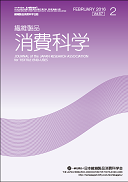
- |<
- <
- 1
- >
- >|
-
[in Japanese]2015Volume 56Issue 1 Pages 6-7
Published: January 20, 2015
Released on J-STAGE: November 28, 2017
JOURNAL RESTRICTED ACCESSDownload PDF (783K)
-
[in Japanese]2015Volume 56Issue 1 Pages 8-9
Published: January 20, 2015
Released on J-STAGE: November 28, 2017
JOURNAL RESTRICTED ACCESSDownload PDF (721K)
-
[in Japanese]2015Volume 56Issue 1 Pages 10-14
Published: January 20, 2015
Released on J-STAGE: November 28, 2017
JOURNAL RESTRICTED ACCESSDownload PDF (1925K)
-
[in Japanese], [in Japanese], [in Japanese]2015Volume 56Issue 1 Pages 15-19
Published: January 20, 2015
Released on J-STAGE: November 28, 2017
JOURNAL RESTRICTED ACCESSDownload PDF (1534K)
-
[in Japanese]2015Volume 56Issue 1 Pages 20-29
Published: January 20, 2015
Released on J-STAGE: November 28, 2017
JOURNAL RESTRICTED ACCESSDownload PDF (2352K) -
[in Japanese], [in Japanese]2015Volume 56Issue 1 Pages 30-33
Published: January 20, 2015
Released on J-STAGE: November 28, 2017
JOURNAL RESTRICTED ACCESSDownload PDF (1232K) -
[in Japanese]2015Volume 56Issue 1 Pages 34-38
Published: January 20, 2015
Released on J-STAGE: November 28, 2017
JOURNAL RESTRICTED ACCESSDownload PDF (1960K)
-
[in Japanese]2015Volume 56Issue 1 Pages 39-44
Published: January 20, 2015
Released on J-STAGE: November 28, 2017
JOURNAL RESTRICTED ACCESSDownload PDF (1518K) -
[in Japanese]2015Volume 56Issue 1 Pages 45-49
Published: January 20, 2015
Released on J-STAGE: November 28, 2017
JOURNAL RESTRICTED ACCESSDownload PDF (1511K)
-
[in Japanese], [in Japanese]2015Volume 56Issue 1 Pages 50-53
Published: January 20, 2015
Released on J-STAGE: November 28, 2017
JOURNAL RESTRICTED ACCESSDownload PDF (1544K)
-
Harumi MOROOKA, Kaeko SANO, Mamiko YATAGAI2015Volume 56Issue 1 Pages 54-60
Published: January 20, 2015
Released on J-STAGE: November 28, 2017
JOURNAL OPEN ACCESSThe water characteristics of pads worn by women for breast shape adjustment after removal of one breast as a result of breast cancer surgery were clarified from the viewpoint of thermal comfort. Six females who had undergone breast cancer surgery participated as subjects. The pad materials studied in the experiment included silicone gel, urethane foam, cotton, and polyester. The results showed that the highest humidity and lowest temperature on the inside of the pad were observed for the silicone pad, for which the hygroscopicity and moisture permeability are approximately zero. In addition, it was found that the mean skin temperature and oral temperature rose rapidly after walking, as physiological responses. The humidity on the inside of the pad was the lowest for cotton padding, for which the hygroscopicity and moisture permeability are high. Assuming that the material has high moisture permeability, it is important for the pad and cover materials to have a high moisture regain in order to reduce thermal discomfort for the wearer.
View full abstractDownload PDF (2331K) -
Masaru OYA, Ryo SOH2015Volume 56Issue 1 Pages 61-70
Published: January 20, 2015
Released on J-STAGE: November 28, 2017
JOURNAL OPEN ACCESSFlow analysis of information relevant to risk of detergents in China was conducted according to the literatures collected using CNKI which is one of the best literature searching sites in China. The literatures were classified into 5 fields; percutaneous poison, harmfulness of fluorescent agents, endocrine-disrupting chemicals (EDC), human health risk relevant to experimental data on toxicity test with mammals and that on toxicity test on living organisms except for mammals.
Results show that information relevant to percutaneous poison was delivered from Japan to China and promoted the establishment of new businesses in China in which unscientific anti-detergents information was utilized. It was found that the dispute on fluorescent agents arose from the antilogy in Chinese legal system. Information relevant to EDC in detergents was derived from Hong Kong or Taiwan. According to the analysis of literature relevant to human health with experimental toxicity data, we can realize that human health risk of detergents often referred to without considering the quantitative factor in chemical toxicity or mechanism of the toxic action of surfactants.
View full abstractDownload PDF (4131K)
-
Kanoko WASHIZU, Nobuyuki KUSAKABE2015Volume 56Issue 1 Pages 71-75
Published: January 20, 2015
Released on J-STAGE: November 28, 2017
JOURNAL OPEN ACCESS
-
[in Japanese]2015Volume 56Issue 1 Pages 76
Published: January 20, 2015
Released on J-STAGE: November 28, 2017
JOURNAL RESTRICTED ACCESSDownload PDF (519K)
-
[in Japanese]2015Volume 56Issue 1 Pages 91-92
Published: January 20, 2015
Released on J-STAGE: November 28, 2017
JOURNAL RESTRICTED ACCESSDownload PDF (1063K) -
[in Japanese]2015Volume 56Issue 1 Pages 93
Published: January 20, 2015
Released on J-STAGE: November 28, 2017
JOURNAL RESTRICTED ACCESSDownload PDF (702K) -
[in Japanese]2015Volume 56Issue 1 Pages 94
Published: January 20, 2015
Released on J-STAGE: November 28, 2017
JOURNAL RESTRICTED ACCESSDownload PDF (772K) -
2015Volume 56Issue 1 Pages 95-96
Published: January 20, 2015
Released on J-STAGE: November 28, 2017
JOURNAL RESTRICTED ACCESSDownload PDF (991K) -
2015Volume 56Issue 1 Pages 97
Published: January 20, 2015
Released on J-STAGE: November 28, 2017
JOURNAL RESTRICTED ACCESSDownload PDF (752K)
-
[in Japanese], [in Japanese]2015Volume 56Issue 1 Pages 98
Published: January 20, 2015
Released on J-STAGE: November 28, 2017
JOURNAL RESTRICTED ACCESSDownload PDF (632K)
-
2015Volume 56Issue 1 Pages 99
Published: January 20, 2015
Released on J-STAGE: November 28, 2017
JOURNAL RESTRICTED ACCESSDownload PDF (604K)
- |<
- <
- 1
- >
- >|